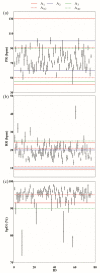Assessment of Remote Vital Sign Monitoring and Alarms in a Real-World Healthcare at Home Dataset
- PMID: 36671610
- PMCID: PMC9854741
- DOI: 10.3390/bioengineering10010037
Assessment of Remote Vital Sign Monitoring and Alarms in a Real-World Healthcare at Home Dataset
Abstract
The importance of vital sign monitoring to detect deterioration increases during healthcare at home. Continuous monitoring with wearables increases assessment frequency but may create information overload for clinicians. The goal of this work was to demonstrate the impact of vital sign observation frequency and alarm settings on alarms in a real-world dataset. Vital signs were collected from 76 patients admitted to healthcare at home programs using the Current Health (CH) platform; its wearable continuously measured respiratory rate (RR), pulse rate (PR), and oxygen saturation (SpO2). Total alarms, alarm rate, patient rate, and detection time were calculated for three alarm rulesets to detect changes in SpO2, PR, and RR under four vital sign observation frequencies and four window sizes for the alarm algorithms' median filter. Total alarms ranged from 65 to 3113. The alarm rate and early detection increased with the observation frequency for all alarm rulesets. Median filter windows reduced alarms triggered by normal fluctuations in vital signs without compromising the granularity of time between assessments. Frequent assessments enabled with continuous monitoring support early intervention but need to pair with settings that balance sensitivity, specificity, clinical risk, and provider capacity to respond when a patient is home to minimize clinician burden.
Keywords: alarm; hospital at home; remote monitoring; vital sign; wearable.
Conflict of interest statement
N.Z., S.G., H.W., E.G. and A.W. are employees of Current Health Inc., Boston, MA, USA, and M.W. is an employee of Current Health Ltd., Edinburgh, UK.
Figures


References
-
- Sapra A., Malik A., Bhandari P. StatPearls. StatPearls Publishing; Treasure Island, FL, USA: 2021. [(accessed on 13 December 2021)]. Vital Sign Assessment. Available online: http://www.ncbi.nlm.nih.gov/books/NBK553213/ - PubMed
-
- NHS England Pulse Oximetry to Detect Early Deterioration of Patients with COVID-19 in Primary and Community Care Settings. 2020. [(accessed on 10 May 2022)]. Available online: https://www.england.nhs.uk/coronavirus/wp-content/uploads/sites/52/2020/....
LinkOut - more resources
Full Text Sources
Research Materials

